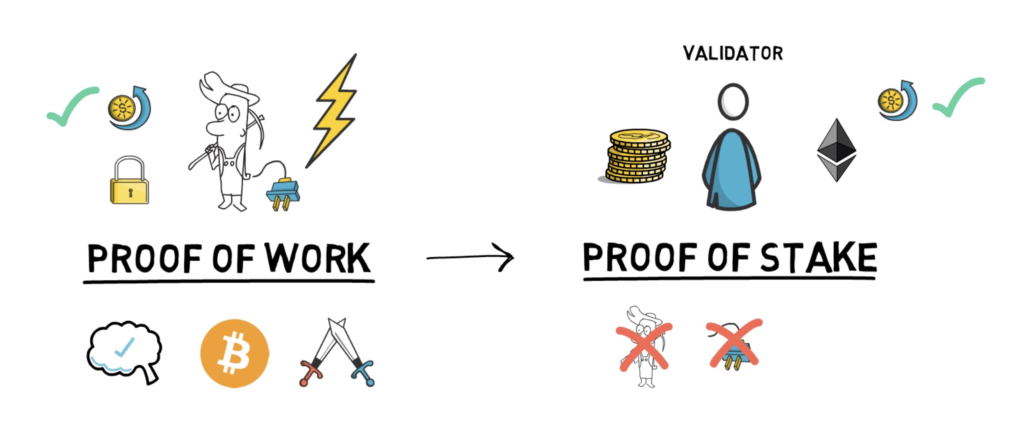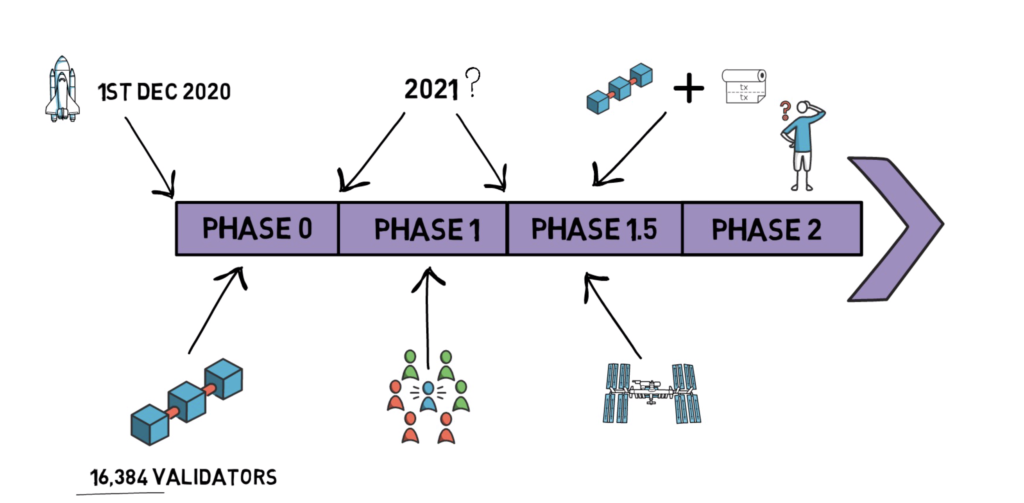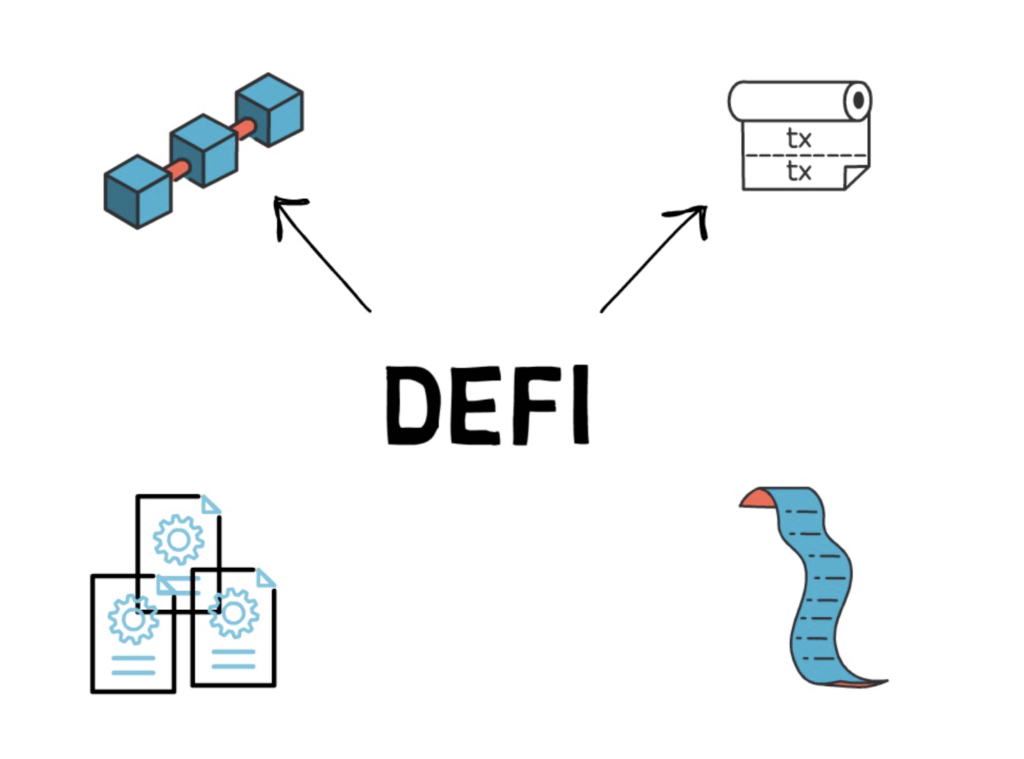So what is the long-awaited Ethereum 2.0 all about? What is Proof of Stake, the Beacon Chain, Sharding and Docking? And what are the different phases of their rollouts? You’ll find answers to these questions in this article.
Overview
Let’s start with an overview of what Ethereum 2.0 is and why it’s even needed in the first place.
Ethereum 2.0 a.k.a Eth2 is a set of interconnected upgrades to the Ethereum network that aims at making Ethereum more scalable, more secure and more sustainable. These changes are worked on by multiple different teams in the Ethereum ecosystem, each team focusing on building a specific part of the whole upgrade.

Now, let’s quickly go through all of the main goals of Eth2.
Scalability
The current Ethereum network supports around 15 transactions per second. This becomes a limiting factor when it comes to onboarding millions of new users and launching many more decentralized applications. To make Ethereum more scalable Eth2 aims at supporting 1000s of transactions per second. One important caveat – the increase in transactions per second should not come at a cost of increasing the size of the nodes in the network.
Security
Security of a decentralized network is always one of the top priorities. Eth2 aims at increasing the security of the network against all forms of attack including a “51% attack” where someone can force through fraudulent changes by controlling the majority of the network.
Sustainability
The well-known proof-of-work based consensus model, used by the current Ethereum network, requires a lot of computing power and energy. Eth2 aims at making Ethereum better for the environment by replacing energy-intensive Proof of Work with Proof of Stake.
Initially, the set of changes needed to achieve these goals was called “Serenity”, but now most people refer to it as Ethereum 2.0 or just Eth2.
What is interesting, is that all of these goals were pretty much always in the Ethereum roadmap, and they had been discussed even before the network officially launched.
Let’s start with one of the biggest changes – the consensus model shift from Proof of Work to Proof of Stake.
Proof Of Stake
The current Ethereum consensus model – Proof of Work – is a well known and battle-tested approach to building cryptocurrencies.

In Proof Of Work, miners invest their resources – mainly electricity – to validate transactions and secure the network. This model requires massive amounts of energy to work properly and protect the network from “51% attacks”.
Proof of Stake tries to address the power consumption concerns by getting rid of the miners completely. Instead of machines securing the network by investing their resources, the Proof of Stake consensus model relies on economic incentives.
In Proof of Stake, users who want to secure the network, stake their ETH and become validators. Each validator is incentivised to validate transactions by receiving, similarly to miners in proof-of-work, both the block reward and the transaction fees.
To discourage validators from trying to game the system and validate fraudulent transactions, the Proof of Stake system implements a mechanism called “slashing” where validators lose part of their staked ETH if they decide to act dishonestly.
In order to pull off a successful “51% attack” in a Proof of Stake system, the attacker would have to control 51% of the validators which would require owning 51% of all staked ETH – a massive amount of capital.
In order to become one of the Eth2 Validators, 32 ETH is required. It is also possible to stake with less than 32 ETH by using staking pools, for example, Rocketpool.
The returns for validators depend on the amount of staked ETH in the system. They can be as high as over 18% annually if there is less than 1M ETH staked and as low as 1.81%, or even lower, if there is more than 100M ETH in the system.

Proof of Stake addresses all 3 of the Eth2 goals. It makes Ethereum more sustainable by removing energy-intensive miners. It makes it more secure by making a “51% attack” harder. And it makes it more scalable by unlocking sharding that would be much harder to achieve in a Proof of Work model as it would most likely result in diluting the amount of computing power across multiple shards.
This is actually a good segway into sharding.
Sharding
The concept of sharding is not specific to the Eth2 upgrade. It’s actually a common process in computer science that allows for splitting a database into multiple instances each containing a portion of the whole data set. Each instance would be known as a “shard”.

When it comes to Eth2, each “shard” is basically a separate new chain. Initially, there will be 64 of them. This directly addresses Ethereum’s scalability concerns as shards will allow for spreading the network’s load.
On top of that, each Ethereum node will only have to run one of the shards. This means storing only a small subset of data and making it easier to run a node without having powerful hardware. Making nodes easier to run should result in more network participants which equals more decentralization and more security.
Initially, sharding will just provide extra data. Sharded chains won’t be able to handle transactions or smart contracts.
At this point, you’re probably asking the question. So how can sharding improve scalability without handling transactions or smart contracts?
Improving scalability will be possible because of layer 2 scaling – in particular rollups. Rollups allow for bundling transactions (and smart contract executions) off-chain, generating a cryptographic proof and submitting it to the chain. This process only requires a data shard to be available to store the proof which means it can be used with the initial version of sharding.
You can learn more about Layer 2 scaling and rollups here.
This is not the end. Although the mix of data sharding and rollups should result in Ethereum being able to process over 100,000 transactions per second, there is also another improvement that can be made. There is a possibility to upgrade shards and make them fully executable in the same way as the current Ethereum chain. It remains to be seen if this improvement will be needed or not depending on how popular the data sharding and rollups solution becomes.
It is also important to mention that in the data sharding model, the current Ethereum chain becomes one of the shards. And this is the only shard that is able to handle transactions and smart contracts.
The Beacon Chain
The Beacon Chain is the next important concept to grasp to fully understand the Eth2 upgrade.
The Beacon Chain is responsible for coordinating a Proof of Stake based system by randomly assigning stakers to validate different shards. Randomness is important as it prevents stakers from colluding and taking over a shard.

The Beacon Chain basically creates a new Proof of Stake network that runs in parallel to the current Ethereum chain. Launching it is one of the first things in the Eth2 roadmap.
Initially, validators will be adding new blocks to the Beacon Chain but they won’t be validating the current Ethereum mainnet transactions. This will be possible, once the current chain becomes one of the Eth2 shards.
Docking
This brings us to the last piece of the whole Eth2 puzzle – Docking.
Docking is a process in which the current Ethereum chain becomes one of the shards in the Eth2 Proof of Stake system.
This process will also mark the end of Proof of Work Ethereum that we know today and the full transition to the new Proof of Stake model.
Docking will bring the ability to run smart contracts into the Proof Of Stake system. On top of that, it will provide the full history and the current state of Ethereum, allowing a smooth transition for all the ETH holders and users.
Phases
Let’s see how all the concepts that we just discussed fit into the Eth2 timeline. The whole development process is split into multiple phases.

Phase 0 is the first phase of shipping Eth2 that focuses on launching the Beacon Chain. To achieve this, a threshold of 16,384 validators has to be reached. The required amount of validators was reached on the 24th of November which allows Phase 0 to be launched on the earliest possible date – 1st of December 2020.
The next phase, Phase 1 focuses on sharding or to be specific – data sharding that we described earlier.
Once Phase 1 is established, next up is Phase 1.5 that focuses on Docking – making the current Ethereum chain one of the shards in Eth2. It looks like both – Phase 1 and Phase 1.5 will be delivered as early as 2021.
After Phase 1.5 is reached, there are 2 possible scenarios. Either the combination of data sharding and rollups will be enough and there is no need for further phases. Or maybe there will still be a need for the full sharding solution which would bring us to the final phase, Phase 2. This will remain to be seen after Phase 1.5 is successfully completed.
Summary
It’s also worth mentioning that even though the initial Phase 0 doesn’t change much when it comes to the current Ethereum chain. It may still have some potentially significant economic implications. This is because the ETH that is being sent to Eth2 validators becomes locked and cannot be withdrawn until Phase 1.5 is complete, which means less circulating ETH in the current system.

When it comes to DeFi, it looks like most activities will be concentrated on either the executable shard or one of the layer 2 rollup solutions – at least initially. This is because DeFi takes huge advantage of smart contract composability and more complex transactions, so having different DeFi protocols that cannot communicate with each other easily doesn’t make much sense.
So what do you think about Eth2? Do you think it will eventually make other smart contract blockchains a.k.a. the “Ethereum killers” irrelevant?
If you enjoyed reading this article you can also check out Finematics on Youtube and Twitter.




